A Comprehensive Guide to Crafting the Perfect Taquito
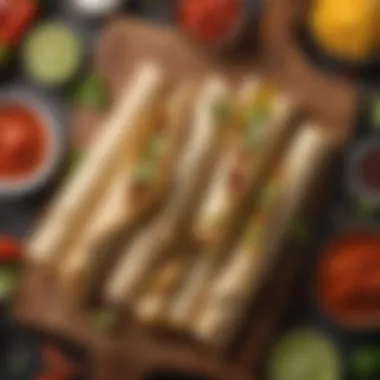
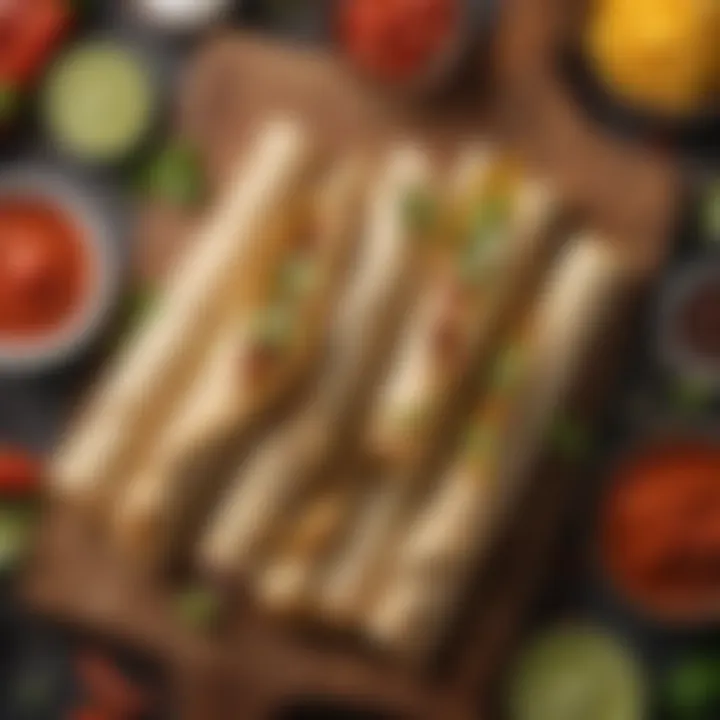
Intro
In the heart of Mexican cuisine lies a beloved culinary treasure: the taquito. Often mistaken simply as a rolled-up tortilla filled with goodness, there is so much more to these delightful morsels than meets the eye. Whether you’re a self-proclaimed food enthusiast or just starting your culinary journey, mastering the art of crafting the perfect taquito can be both rewarding and delicious. This guide aims to take you through every twist and turn, from the rich history surrounding this dish to the diverse techniques and ingredients at play.
While one might think taquitos are plain and straightforward, a deeper exploration reveals a world of flavors and textures, rooted in tradition and personal adaptations. As we navigate through the various layers of this guide, you’ll discover not only the essential components needed for a stellar taquito but also the creative liberties you can take to make the dish your own.
The culinary landscape is ever-evolving, reflecting not just the ingredients but the hands that prepare them. From the crunchy exterior to the tender insides packed with spices, every bite of a well-crafted taquito tells a story. So, whether you're looking to impress friends at your next gathering or simply want to enjoy a homemade version of this classic dish, let's dive into the essentials and edge you closer to taquito perfection.
Recipe Overview
Recipe Name and Description
The taquito, sometimes referred to as a ‘flauta’ in certain regions, is a quintessential Mexican street food, characterized by its crispy exterior and savory fillings. They’re typically corn tortillas rolled around fillings such as beef, chicken, or cheese, then fried to achieve a golden crunch. Served often with guacamole, salsa, or sour cream, they offer a delightful balance of textures and flavors.
Cuisine Type
This dish is rooted in Mexican cuisine, but its variations have made it popular in many other cultures, especially in the United States. Depending on where you find yourself, the fillings, tortilla types, and accompanying sauces can vary dramatically.
Ingredients List
Detailed Ingredient Breakdown
Crafting taquitos requires a few key players:
- Corn Tortillas: Essential for that authentic rolled form, the flour tortilla is an alternative, but it lacks the classic flavor.
- Protein: Common choices include shredded beef, chicken, pork, or even beans for a vegetarian option.
- Cheese: A good melting cheese, like Monterey Jack or queso fresco, adds creaminess to balance out the dish.
- Herbs/Spices: Cumin, garlic powder, or fresh cilantro can elevate the flavor profile substantially.
- Oil: For frying, a neutral oil such as canola or vegetable oil works best to achieve that crispy texture.
Substitutions for Dietary Needs
Not every taquito needs to stick to tradition. Here are some substitutions you might consider:
- Tortillas: Opt for gluten-free corn tortillas to accommodate a gluten intolerance.
- Protein Alternatives: Substitute meat with jackfruit or a combination of grains and beans for a vegan approach.
- Dairy-Free Cheese: Use non-dairy cheese options if you’re trying to keep things lactose-free.
Before embarking on this taquito journey, it’s important to familiarize yourself with the array of ingredients that can be both traditional and modern. Taking the time to understand each component will set the foundation for your culinary adventure.
Historical Context of Taquitos
Understanding the historical context of taquitos is like peeling back the layers of a well-crafted dish: each layer adds flavor and depth to the final experience. Taquitos, often appreciated merely for their taste, carry with them a rich heritage that’s deeply intertwined with Mexican culture and identity. By exploring this facet, we can appreciate not just the taquito itself, but also the vibrant community and traditions that birthed it.
Origins of Taquitos
The journey of taquitos dates back to ancient Mexico, where the use of corn tortillas was prevalent in culinary practices. Corn, a staple in the Mexican diet, provided nourishment and versatility. Farmers would originally take leftover meats or beans, combined them with spices and herbs, roll them in tortillas, and then fry them—a method born out of resourcefulness and necessity.
Nopales and mushrooms also played a significant role in early taquito fillings, especially in areas where meat was less accessible. As various regions in Mexico developed their own cultural identities, so too did the taquito. In fact, it’s said that the name ‘taquito’ means ‘small taco’, but the dish itself transformed significantly over the decades. Some cultures adopted the practice and adapted it to their local ingredients and traditions, leading to the delightful variations we see today.
Cultural Significance
Taquitos symbolize more than just food; they are a celebration of heritage, family, and togetherness. Historically, these rolled delicacies have appeared in family gatherings and local festivals, showcasing the importance of sharing meals within communities.
"Food is an integral part of our culture, and taquitos are a bridge between generations, passing down flavors and stories."
In times of celebration—to birthdays or national holidays—taquitos take center stage, often served alongside vibrant salsas and dips, highlighting their role in festive occasions. Moreover, they have crossed borders, contributing to the growing popularity of Mexican cuisine globally. In Mexico, there isn’t simply one way to make taquitos; techniques and fillings vary from one city to another. This diversity reflects the country’s multifaceted culinary landscape.
In essence, the historical backdrop of taquitos enables us to delve deeper into their significance, appreciating them not as mere food, but as a slice of Mexican culture that unites people and traditions. Understanding this context will enrich your experience when you make taquitos in your own kitchen, knowing you're carrying forward a culinary tradition that has stood the test of time.
Key Ingredients in Taquitos
When it comes to crafting the perfect taquito, the significance of key ingredients cannot be overstated. These components are not merely the filling and the wrapper; they are the foundation upon which the entire dish is built. Understanding the nuances of each ingredient contributes to a deeper appreciation of the taquito and enhances the end product, so let’s unpack this a bit further.
Tortillas: A Foundation
Tortillas are more than just the outer shell; they are the very essence of a taquito. Typically made from corn or flour, the choice of tortilla affects the flavor and texture dramatically. Corn tortillas tend to be more traditional, offering that unmistakable earthy flavor, while flour tortillas can provide additional pliability, making them easier to roll.
When selecting tortillas, freshness is key. Using tortillas straight from a local tortilleria or those made from scratch can elevate the dish. The thickness of the tortilla also plays a crucial role; too thick, and you risk losing the crispiness, too thin, and the filling may break through. Pay attention to size as well, since smaller tortillas create a perfectly bite-sized taquito.
Filling Options
The filling of a taquito can make or break the entire experience. A variety of options exist here, each offering a different character and catering to personal preferences.
Meat Varieties
For many, meat is the star of the show. Think of grilled chicken, slow-cooked beef, or spicy pork. The appeal of meat varieties lies in their robust flavors and the way they marinate, providing a savory contrast to the crisp tortilla.
Ground beef is a classic choice, often seasoned with spices that pack quite the punch. Chicken, however, is nearly as popular, particularly when seasoned with aromatic herbs and spices or perhaps slow-cooked with a touch of smokiness.
Nevertheless, there's conversation around the disadvantages—dishes can sometimes turn greasy, and the quality of meat can heavily impact the overall flavor.
Vegetable Alternatives
If you’re leaning toward plant-based options, don't overlook vegetable alternatives. Options like roasted vegetables, mushrooms, or even a medley of beans can create a flavorful filling that's both satisfying and nutritious.
The great thing about veggie fillings is the creativity involved; you’re not bound by tradition. Take, for instance, sweet potatoes mixed with black beans and spices. The sweetness of the potato balances beautifully with the spices, and the texture can mimic that of meats.
A downside, of course, is that some may not feel as filling as meat, leading to the idea that you might have to create a more substantial portion to satisfy a hearty appetite.
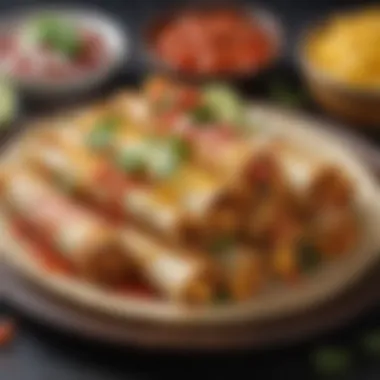

Cheese Additions
Cheese further enriches the taquito experience with both creaminess and flavor. From traditional queso fresco to a sharp cheddar, cheese has a unique ability to provide that gooey texture everybody loves.
The melting aspect is essential; a well-chosen cheese will create that delightful stretch, providing joy in every bite. However, keep in mind the richness that cheese brings in; it's wise to balance it with the filling so that it doesn’t overwhelm the other flavors.
Seasoning and Sauces
The finishing touch to any taquito is in its seasoning and sauces. From a simple dash of salt to more complex spice blends, the right seasoning can elevate your taquitos from basic to extraordinary.
Consider salsas, guacamole, or crema—which not only add flavor but can enhance the textural contrast as well. The right dipping sauce can make a world of difference, rounding out your dish beautifully.
In sum, each component of taquitos works in harmony. Selecting the right tortillas, fillings, and seasonings ensures that your culinary adventure is rewarding and delectable. Embracing the variety and experimenting with both tradition and innovation will guide you towards the ultimate taquito.
"The beauty of taquitos lies not just in what you put inside but in the love and thoughtfulness you put into crafting each bite."
By understanding the components and experimenting, the art of making taquitos transforms into a delightful journey that caters to various tastes and preferences.
Preparation Techniques for Taquitos
The art of making taquitos transcends mere following of a recipe; it involves a careful orchestration of techniques that can significantly affect the final outcome. Preparation techniques are essential as they determine not just the taste but also the texture and overall enjoyment of this beloved dish. A well-crafted taquito has a crispy exterior that gives way to a warm, flavorful filling, that's worth celebrating.
Cooking the Fillings
The filling is the heart and soul of a taquito, and its preparation requires special attention. Whether you choose shredded beef, seasoned chicken, or a medley of grilled vegetables, ensuring that your filling is sufficiently cooked is crucial. Cooking the fillings allows flavors to develop and meld together, making each bite a burst of deliciousness.
- Flavor Depth: Simmering meats or sautéing vegetables with spices can create complex, aromatic profiles that enhance the overall dish.
- Moisture Control: It is essential to avoid overcooking, which can dry out ingredients. Striking a balance ensures a tender, juicy filling.
- Temperature Considerations: Fillings should be warm when wrapped in tortillas. Cold fillings can lead to soggy taquitos or make them break when rolled.
Rolling and Securing
Rolling a taquito may seem straightforward, but there’s a finesse to it that can significantly impact how they cook and hold up. A well-rolled taquito not only cooks evenly but also keeps its contents tucked in.
- Tortilla Temperature: Use warm tortillas which are more pliable and less prone to cracking. If they’re cold, you risk substantial tearing during the rolling process.
- Filling to Tortilla Ratio: Striking the right balance is key. Overfilling can lead to messy results, while underfilling can create less satisfying taquitos.
- Sealing Techniques: You can use a bit of flour paste (flour mixed with water) to secure the ends. This nifty technique helps ensure each taquito holds its shape during cooking.
Frying vs. Baking
The method of cooking your taquitos can make a world of difference to the final dish. Both frying and baking have their merits and can lead to delicious results, but the choice largely depends on your personal preference and dietary considerations.
- Frying: Traditional taquitos are often fried. This method provides that golden, crispy texture that is hard to resist. However, it does require careful attention to oil temperature. Too hot, and the taquitos burn; too cool, and they absorb too much oil.
- Baking: An alternative that appeals to health-conscious cooks. When baked, taquitos can still achieve a lovely crispiness, especially if brushed lightly with oil beforehand. However, they might not carry the same rich flavor as their fried counterparts.
Ultimately, the preparation techniques you choose will shape your taquito experience. Whether opting for the classic fry or the healthier bake, understanding each element of preparation helps elevate your culinary skills.
In summary, mastering the preparation techniques is about achieving the perfect texture and flavor profile. Properly cooking fillings, skillfully rolling, and wisely choosing your cooking method are every bit as important as choosing the right ingredients.
Achieving the Ideal Texture
When it comes to taquitos, texture is king. It can make or break the entire eating experience. A perfectly crunchy taquito paired with the right level of filling can create a symphony of flavors that keeps you reaching for more. Thus, understanding the elements that contribute to achieving that coveted texture is essential.
Crispiness Factors
Crispiness in taquitos isn't just about the frying technique; it involves a combination of several factors. First off, let's talk about the tortillas. Using corn tortillas, preferably freshly made or at least warmed, provides that authentic crispiness that is so sought after. They should be pliable enough to roll but firm enough to become crispy during frying.
Another vital element is the frying temperature. A common mistake is not heating the oil adequately. The ideal range is between 350°F and 375°F. If the oil is too hot, you risk burning the taquitos, and if it's too cold, they turn out greasy and soggy. Monitoring this temperature with a reliable thermometer will ensure your taquitos are crisp instead of mushy.
Moreover, frying in batches is a worthwhile practice. If you overcrowd the pan, the oil temperature will drop significantly, leading to disappointment in the crisp texture you crave. Keep the batches small and let them fry undisturbed for a few minutes until golden brown.
“The texture of a taquito speaks volumes about your cooking skills. Achieving that perfect crispness shows dedication to the craft.”
Timing in Cooking
Timing in cooking plays an equally critical role in the quest for a perfectly textured taquito.
Once you've rolled your taquitos and are ready to fry, it's essential to avoid any form of distraction. A mere minute can change their fate from perfectly toasted to a rubbery disappointment. Depending on the heating method and size of your taquitos, cooking times may vary.
A good rule of thumb is to fry them for about 3 to 4 minutes per side. This allows enough time for the fillings to heat thoroughly while also achieving that golden-brown exterior.
For those opting for baking instead, around 15 to 20 minutes at 400°F will get you a good result but don’t forget to flip them halfway through the baking time. While they won't have the exact crunch as frying, this method can provide a pleasing crispiness when done right.
Common Mistakes When Making Taquitos
When it comes to making the perfect taquitos, there are certain pitfalls that can trip up even the most experienced cooks. Understanding these blunders is vital not only for perfecting your own cooking techniques but also for truly appreciating this traditional dish. Each mistake can lead to a taquito that falls flat, both in flavor and texture, detracting from the culinary experience. Let's dig into these common missteps to ensure your taquito game is on point.
Overfilling
One of the cardinal sins in taquito preparation is overfilling your tortillas. While it may be tempting to pack the filling to the brim, this often results in a disastrous end. A taquito should boast a perfect balance between the crispy tortilla and the flavorful filling. Too much filling can cause the tortillas to burst during cooking, leading to a mess and leaving you with a subpar result.
Tip: Aim for about two tablespoons of filling per tortilla. This will allow for tight rolling without compromising the integrity of the wrap. Don’t try to stuff your taquitos as if you’re packing a suitcase! Keep it light, and your taquitos will emerge crispy and delightful.
Using Cold Tortillas
Another common mistake is using cold tortillas. Freshly made or warmed tortillas roll more easily and hold together better, contributing to a superior taquito. Cold tortillas are rigid and can snap when you try to roll them, leading to uneven cooking. This results in broken taquitos that can’t possibly hold up against the various dips and sauces.
To avoid this faux pas, always warm your tortillas prior to assembling your taquitos. Whether you choose to utilize a microwave, a skillet, or a steam method, ensure they are pliable before loading them up with your filling.


Inconsistent Cooking Temperatures
Inconsistent cooking temperatures can sabotage your efforts in a heartbeat. If the oil for frying isn’t hot enough, the taquitos will absorb excess oil, turning into greasy pillows rather than golden, crisp delights. On the flip side, if the oil is too hot, the exterior might brown rapidly while the inside remains cold or undercooked. This delicate balance can make or break your dish.
To maintain consistent cooking temperatures:
- Use a thermometer to monitor oil temperature, aiming for around 350°F to 375°F.
- Fry in batches to avoid cooling down the oil too much.
- Have a heat-resistant slotted spoon ready to test for doneness. When the taquitos sizzle gently upon contact with the oil, it’s game on.
"Consistency in kitchen technique is key to achieving culinary masterpieces."
By steering clear of these common mistakes, you’re on the right path to crafting taquitos that are not only aesthetically pleasing but also bursting with flavor. Remember, the road to culinary perfection is paved with learning from missteps and refining your techniques. Master these and you’ll see your taquito making elevate to a whole new level.
Taquito Variations Across The Globe
Taquitos, while rooted in traditional Mexican cuisine, have evolved into a culinary canvas, embracing flavors and techniques from around the globe. Understanding the variations of taquitos is essential not only for appreciating their versatility but also for discovering how different cultural influences can create a whole spectrum of taste experiences. This section dives into the distinct regional adaptations found in Mexico and how international ingenuity has transformed taquitos into something uniquely global.
Mexican Regional Differences
In Mexico, the beauty of culinary diversity shines brightly when it comes to taquitos. Each region has its suggestions, reflecting local ingredients and preferences. For instance:
- Taquitos de Barbacoa in states like Hidalgo feature slow-cooked lamb, seasoned with herbs and spices. It’s a dish passed down through generations, often served during festive gatherings.
- Taquitos de Pibil, originating from Yucatán, offer a distinct twist. The fillings come from meats marinated in achiote paste and citrus juice, and are cooked in a banana leaf, giving a smoky essence.
- Fried Taquitos in Baja California come with a seafood twist, leveraging fresh fish or shrimp, wrapped snugly. This adaptation beautifully integrates the coastal bounty into a beloved snack.
These regional differences express the unique cultural tapestries found in Mexico, emphasizing local traditions and the freshest ingredients. The variety ensures that no two taquitos are really the same, as each reflects not only the culinary practices but also the heritage of its place of origin.
International Adaptations
Once taquitos made their way across borders, they began to adapt to local palates, making them a hit in various international cuisines. Here are some fascinating adaptations:
- American Style Taquitos often incorporate processed cheese and various sauces, catering to fast-food culture. With options like chicken, beef, or even vegetarian fillings, they have transformed into popular staple snacks on the go.
- Asian Fusion Taquitos can be found in trendy restaurants, where chefs mix traditional taquito elements with ingredients like teriyaki chicken or kimchi. This blend introduces an exciting contrast – the crispy exterior of a taquito with the bold flavors of Asian cuisine.
- Vegetarian and Vegan Versions are increasingly popular worldwide, with restaurants offering fillings like jackfruit, lentils, or mushrooms. These versions cater to the growing demand for plant-based meals while maintaining the crunchy appeal that taquitos are known for.
Adaptations of taquitos demonstrate the dish's flexibility, embracing global influences while staying true to its essence.
Serving Suggestions for Taquitos
When it comes to enjoying taquitos, how you serve them can elevate the entire experience. Whether you're enjoying a cozy family dinner or throwing a lively gathering, knowing how to present taquitos and what to pair them with can enhance their flavors immensely. This section explores the essential accompaniments and plating techniques that complement taquitos and make them an attractive treat on your table.
Accompaniments
Salsas
Salsa is like that extra spark that takes your taquitos from good to absolutely unforgettable. This vibrant mix of ingredients, often featuring tomatoes, onions, and a variety of peppers, offers a burst of freshness in every bite. The key characteristic of salsas is versatility—each variety brings its own unique flavor profile to the table.
For instance, pico de gallo is a raw salsa that adds a crunchy refreshing element, while a smoky chipotle salsa can provide that deep, rich flavor that many seek. Furthermore, salsa's acidity can cut through the richness of the taquito, balancing the profile on your palate.
However, it's essential to understand that not all salsas are created equal. Some may be more spicy than others, which can be a double-edged sword. If you're serving a crowd, it's a good idea to have a mild option available alongside heartier flavors—just to keep everyone happy.
Guacamole
Guacamole is a classic companion, often regarded as a staple when serving taquitos. Perhaps it’s because of that creamy texture that lends a luxurious quality to the dish. The key characteristic here is the balance of flavors—perfectly ripe avocados mingled with lime juice, cilantro, and hints of garlic come together to create a refreshing dip that can soothe any spice hit from the taquitos.
What sets guacamole apart is its ability to adapt. You can leave it chunky or whip it into a smooth paste, making it versatile for different diners' preferences. Its richness complements fried or baked taquitos exceptionally well, playing off their crispy textures nicely.
Yet, like salsa, guacamole isn't without its drawbacks. Avocado can be pricey and if not prepared properly, guacamole can brown quickly. Still, its deliciousness when done right is often worth the effort and cost.
Crema
When you're aiming for that creamy touch to balance out the crunch, crema is the way to go. This Mexican-style sour cream is thicker and tangier than regular sour cream, but it also has a pleasing silkiness that makes it ideal for drizzling over your taquitos. The key characteristic of crema is its ability to mellow out spicy flavors, allowing the more subtle nuances of the taquito filling to shine through.
Crema's unique feature lies in its preparation—it can be spiced up with a hint of lime or seasoned with spices to suit your palate. This adaptability is a significant advantage, and it allows you to tailor the crema to complement your chosen fillings.
However, it may not appeal to dairy-free eaters or those who shy away from rich environments. Yet, offering a dairy-free alternative, such as cashew cream, can ensure everyone enjoys their meal.
Plating Techniques
Plating is where your creativity can run wild.
Using a clean or textured plate, you can attractively arrange the taquitos. Here are some ideas:
- Stacking: Layer them in a slight zigzag for height.
- Dipping bowls: Embed small bowls of salsa, guacamole, and crema around your taquitos for an enticing display.
- Garnishes: Use fresh herbs or lime wedges for color and extra flavor.
Always remember, how you present the taquitos can entice your guests even before the first bite. A well-plated dish encourages an enthusiastic response, makings meals memorable regardless of the ingredients used.
Nutritional Considerations
Understanding the nutritional value of taquitos is essential for anyone who enjoys this dish. When you’re whipping up a batch of taquitos, you want to make sure they taste great but also contribute positively to a well-rounded diet. Taquitos can be both delicious and nutritious, depending on the ingredients chosen and the preparation methods employed. Knowing how to balance flavors and health can enhance not just your meal, but enrich your overall well-being.
Caloric Breakdown
Taquitos, like many other comfort foods, carry varying caloric content depending on their components. It's helpful to look at the caloric values that come from each main ingredient. Typical beef or chicken-filled taquitos might hover around 200 to 300 calories per serving when fried. If you're considering baked taquitos, which often contain less oil, you may cut those calories by a good chunk.
For instance, a traditional taquito filled with shredded beef, cheese, and a corn tortilla may provide:
- Tortilla: 80-100 calories
- Filling: 150-200 calories
- Oil for frying: approx 40-80 calories per taquito
Total: Around 270 to 380 calories
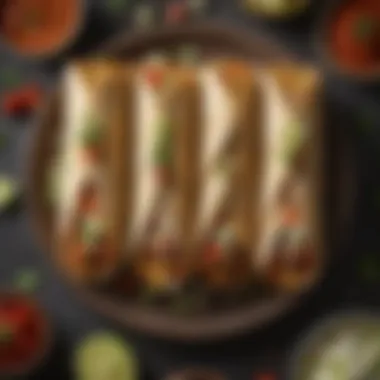
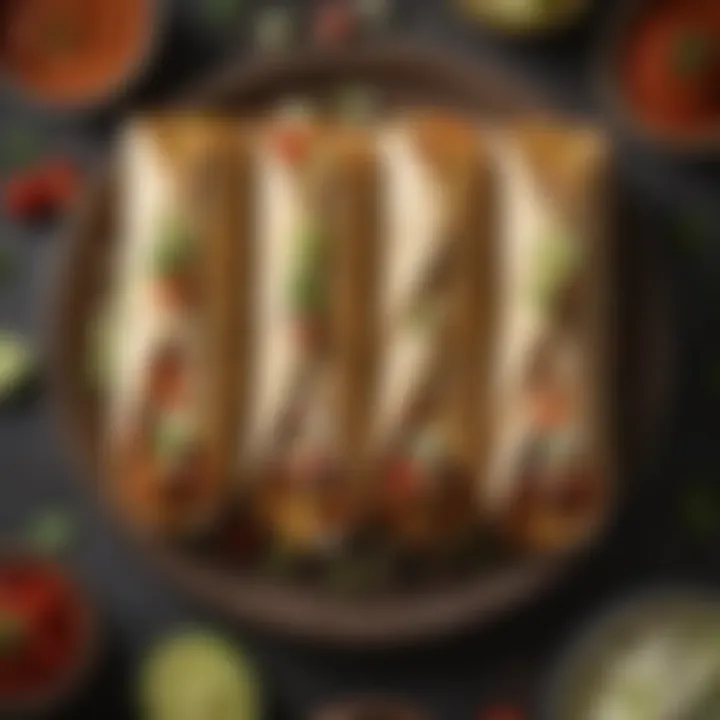
It's easy to overlook how quickly the calories can add up when making these crispy treats. Being aware of what goes into your taquito will help you keep track of your caloric intake. Plus, lighter alternatives can keep the tummy satisfied without weighing it down too much.
Healthier Alternatives
Whole Grain Tortillas
Whole grain tortillas provide a fantastic alternative to the standard white tortillas. The whole grain option is packed with fibers, which can assist in digestion and help promote a feeling of fullness. When you choose whole grain tortillas, you add important nutrients to your taquitos, like B vitamins and minerals such as iron and magnesium.
- Key Characteristic: High fiber content.
- Benefit: Better for digestion and satiation.
That makes them a nutritious rather than a filler ingredient in your taquito recipe. However, it’s worth noting that those who prefer the traditional flavor might find whole grain tortillas less appealing. Taste can vary, and some may not like the nuttier flavor profile.
Lean Proteins
Incorporating lean proteins is another sure-fire way to make your taquitos more nutritious. Options like chicken breast or turkey can cut down on fat while delivering the protein needed for muscle recovery and satiety. Lean proteins are popular for those who are health-conscious or looking to control their weight.
- Key Characteristic: Low-fat content.
- Benefit: More protein with less overall fat calories.
Using lean proteins means your taquito won’t feel like a guilty pleasure, allowing you to enjoy them with less worry about piling on unwanted calories. The drawback? Some may argue that the flavors can be a bit milder than traditional fatty cuts.
Exploring nutritional considerations enables everyone to find their perfect taquito balance, whether you're opting for traditional or modern, health-conscious variations.
Overall, integrating these alternatives doesn’t just make your dish healthier; it also opens the door to innovative flavors and ideas that can elevate your cooking game.
Storing and Reheating Taquitos
When it comes to savoring your homemade taquitos days after making them, correct storage and reheating are crucial steps. Knowing how to keep these crispy snacks fresh can save time and reduce food waste. Not to mention, properly reheated taquitos can maintain their delightful crunch and flavorful fillings. Whether it's a busy weeknight or a cozy weekend gathering, understanding the nuances of storing and reheating taquitos enhances their appeal.
Storage Techniques
To maximize the deliciousness of your taquitos during storage, consider the following methods:
- Cooling Before Storage: Allow taquitos to cool completely before placing them in any container. This prevents steam from making them soggy.
- Use Airtight Containers: Store taquitos in airtight containers to keep moisture at bay. Alternatively, you can wrap them in plastic wrap before placing them in a container for added protection.
- Freezing for Longevity: If you've made more taquitos than you can eat in a few days, freezing is an excellent option. Lay them in a single layer on a baking sheet to freeze, then transfer to a freezer-safe bag once solid. This method prevents them from sticking together.
- Labeling: Don't forget to label your storage bags or containers with the date. This way, you can enjoy the goodness without the fear of consuming them too late. Taquitos can be stored in the refrigerator for about 3-4 days and in the freezer for up to three months.
Subsequent Reheating Methods
The way you reheat taquitos can make all the difference between a dull snack and a gastronomic experience. Here are some options:
- Oven Reheating: Preheat your oven to 400°F (about 200°C). Place the frozen or refrigerated taquitos on a baking sheet lined with parchment paper. Bake for about 10-15 minutes, flipping once halfway through. This method helps retain the crunch and warmth of the taquitos.
- Air Fryer: For those with an air fryer, this device works like magic. Set it to 350°F (around 175°C) and air fry for about 5-8 minutes. The result is a perfectly crispy exterior without needing much oil.
- Skillet Method: Heat a non-stick skillet over medium heat. Add a minimal amount of oil and place the taquitos in the pan. Heat for about 3-5 minutes on each side, ideally until golden brown. This method gives a freshly fried feel to your reheated taquitos.
Cooking methods matter; perfect reheating is key to transforming leftovers into a delightful experience.
- Microwave (Quick Option): If you're in a hurry, you can use the microwave. Wrap taquitos in a damp paper towel and microwave for 1-2 minutes. This might make them a bit softer, but in a pinch, it's a viable option.
By mastering the art of storing and reheating taquitos, you ensure that every bite remains as enjoyable as when they were freshly made. This approach not only respects your culinary efforts but also caters to your future cravings.
Incorporating Taquitos into Meal Planning
Incorporating taquitos into meal planning offers a delicious and flexible option to elevate your dining experiences. They are more than just quick snacks; these crispy delights can play a starring role in your family meals, gatherings, or even meal prep. The beauty of taquitos is their adaptability—whether you’re aiming for a quick weeknight dinner or putting together a special occasion spread, they can fit the bill perfectly. They allow for a range of fillings, catering to diverse tastes within a household and turning leftover ingredients into something delightful.
Quick Meal Solutions
When time is short but hunger is knocking loud, taquitos can shine as an efficient meal solution. Imagine getting home after a long day, already mentally exhausted, and yet you want to serve up something that's not only quick but also satisfying. Here are a few handy strategies:
- Prep Ahead: Set aside some time on the weekend to fill and roll your taquitos. Keep them in the fridge or freeze them for later. You can then simply fry or bake them when it's time to eat.
- Simple Fillings: Use ingredients like shredded rotisserie chicken, canned beans, or cheese to create fillings that come together in a pinch. These ingredients usually don’t need cooking or can be prepared in advance.
- One-Pan Wonders: Consider a taquito bake—line the taquitos up in a baking dish, sprinkle with cheese, and pop them in the oven. This way, multiple servings are ready at once, making it perfect for dinner.
The key here is to minimize time without sacrificing flavor. This ensures that you still get to enjoy home-cooked meals even on the busiest nights.
Family-Friendly Choices
Taquitos have that magic touch that can please even the pickiest of eaters, making them a family-friendly choice. They aren’t just a hit among adults but also cater well to kids. Here’s how to incorporate them into family meal planning:
- Customizable Options: Let everyone create their own taquito masterpiece at a meal assembly station. Provide an array of fillings—think seasoned beef, mixed veggies, and various cheeses. This way, kids can pick what they like, making them more likely to join in and eat.
- Mini Versions: For younger ones, smaller taquitos are not just adorable but also easier to handle. You can use smaller tortillas or cut larger ones into bite-sized pieces, serving them with dips that kids can’t resist.
- Nutritious Additions: Sneak in some veggies like spinach or bell peppers into the filling. When prepped and rolled right, kids may not even notice they are eating their greens.
Encouraging involvement in the kitchen can also boost their interest in food. By making taquitos together as a family, you promote healthy eating habits while keeping the fun alive.
"Meal planning becomes less of a chore and more of an enjoyable experience when you can rely on versatile recipes like taquitos."
In the bigger picture, incorporating taquitos into meal planning doesn’t just solve the daily question of ‘what’s for dinner?’ It fosters creativity and fun within mealtime, turning cooking into a family bonding activity while still being a scrumptious choice. Whether for quick solutions or family-friendly dinners, the taquito comes out on top.
The End: The Enduring Appeal of Taquitos
Taquitos hold a special place in the culinary landscape, weaving together tradition and flavor in a way that continues to resonate across generations. Their versatility makes them suitable for a variety of occasions, whether it's a casual weeknight dinner or a festive gathering. As we wrap up this comprehensive guide, it's essential to reflect on a few critical aspects that contribute to their lasting charm.
Summarizing Key Points
In our exploration of taquitos, we have identified several elements that highlight their magnetic appeal:
- Diverse Ingredients: From classic meat fillings to vibrant vegetable options, taquitos cater to various dietary preferences.
- Culinary Techniques: The roles of cooking methods—frying, baking, or even air frying—can drastically alter the texture and taste, encouraging cooks to experiment.
- Global Variations: Different regions and cultures have adapted taquitos, adding unique twists that showcase local flavors and ingredients. This adaptability is a testament to their universal appeal.
- Health Considerations: The ability to craft healthier versions, using whole grains and lean proteins, allows taquitos to fit into modern, health-conscious diets without losing their essence.
Reflecting on these points, it's evident that taquitos are more than just a delicious snack. They embody the spirit of culinary creativity, allowing anyone to make them fit their tastes and needs.
Inviting Culinary Exploration
The journey doesn’t have to end here. Taquitos invite you to experiment and discover your own interpretations.
- Try New Fillings: Use ingredients you might not typically associate with taquitos. Think beyond the usual beef or chicken and explore options like pulled pork or even quinoa for a vegetarian twist.
- Tweak the Seasonings: Don’t be afraid to play with spices. Adding a pinch of cumin or a dash of smoked paprika can elevate the flavor profile dramatically.
- Make It a Family Affair: Involve family and friends in crafting taquitos. Cooking can be a bonding experience, and everyone can contribute their ideas on fillings and sauces.
- Share Your Creations: Take to social media to showcase your unique taquito recipes. Platforms like Reddit or Facebook can be a great place to share and discover new approaches.
Ultimately, the enduring appeal of taquitos lies in their ability to adapt and satisfy. Whether you prefer them crispy or soft, filled with meat or veggies, each bite tells a story of creativity and tradition. So, go ahead, roll up your sleeves, and dive deeper into the tantalizing world of taquitos.















